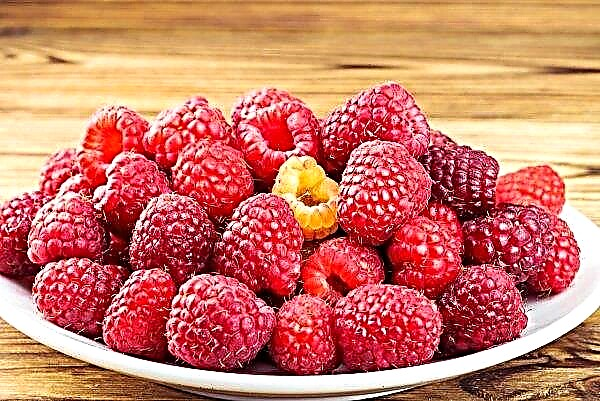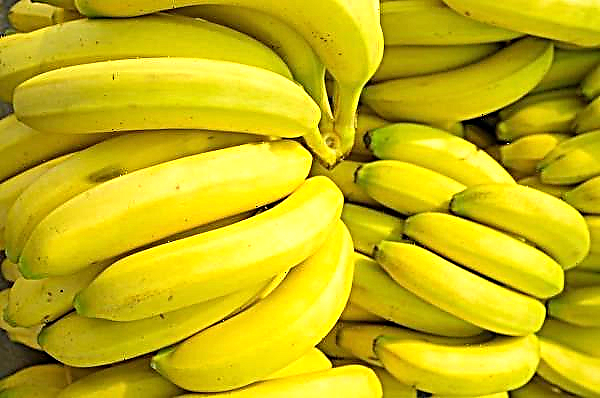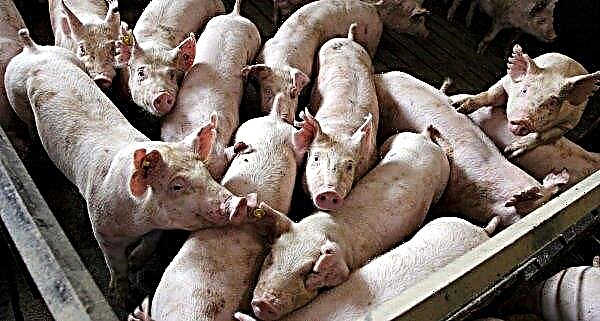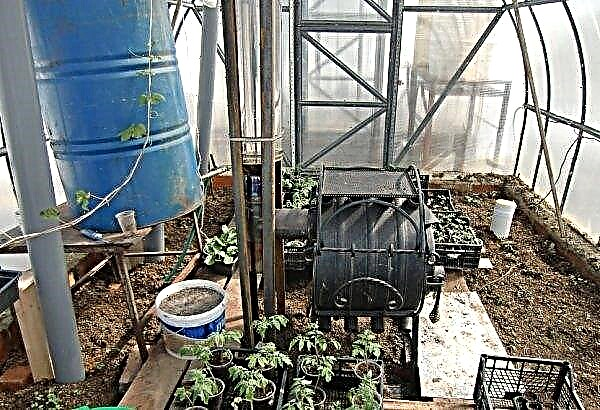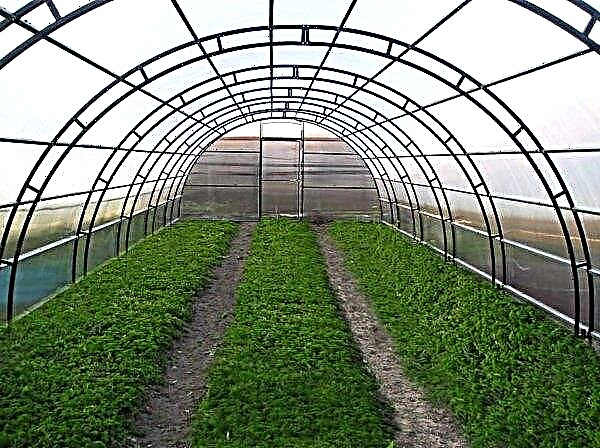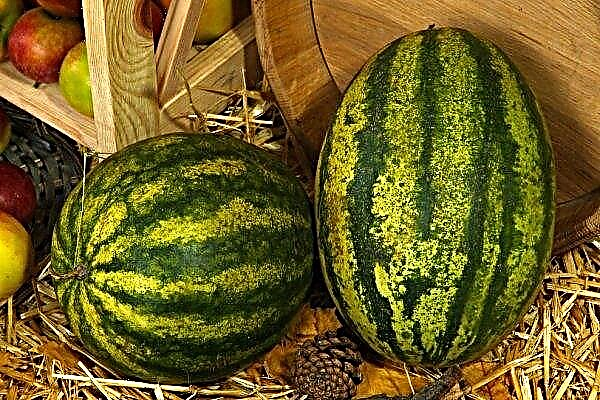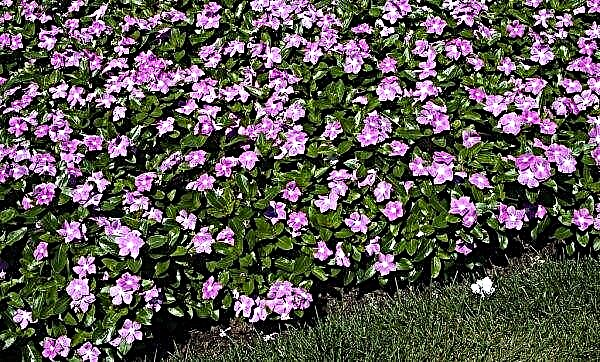There is always room for early tomato varieties in the garden. In the south of the country, their seeds can be sown directly into the ground, but the seedlings will allow you to get earlier products. We learn more about an early ripe tomato hybrid called My Love F1, about its main characteristics, advantages over other varieties and disadvantages, as well as how to grow it.
History of Variety Breeding
Variety My Love F1 is a hybrid bred by a professional breeder - candidate of agricultural sciences L. A. Myazina. In 2008, it was included in the State Register of the Russian Federation and recommended for cultivation throughout the country. It can be grown in unprotected soil and in various types of shelters.
Did you know? Red tomato varieties are considered the most useful due to the high content of the lycopene carotenoid, which has a beneficial effect on vision and the cardiovascular system and is a prevention of cancer.
Characterization and description of the variety
This is an early variety, the fruits of which can be harvested after 85-100 days from the appearance of seedlings. This determinant plant forms a powerful, slightly deciduous standard bush from 0.5 m in height. 
In greenhouse conditions, it can grow up to 1.2 m, and in open beds it is shorter. It stops growing after the appearance of the fifth inflorescence. The variety is unpretentious and resistant to temperature changes and hot weather, has good immunity and, thanks to its early ripening, does not have time to be affected by late blight.
Productivity
With the creation of favorable conditions and proper care, the yield can reach 10 kg from 1 m². Sometimes from one bush collect up to 5 kg of products.
Pay attention to other varieties of determinant tomatoes:
Description of the fetus
On each hand, 5–6 one-dimensional red fruits are tied. They have a rounded shape, slight ribbing and a characteristic nose, which may be absent in bad weather conditions. Small fruits of moderate density and an average weight of 150-200 g have from 6 seed chambers. The pulp is tender and sweet, melts in the mouth. Small tomatoes are great for preparing a variety of dishes and preservation.
Advantages and disadvantages of the variety
- Compared to other varieties, the hybrid My Love F1 has the following advantages:
- friendly and early ripening of the crop;
- no need for garter and stepsoning;
- ability to grow well in sheltered and unprotected soil;
- the fruits do not crack;
- presentation of products;
- great taste;
- universal use of fruits;
- tomatoes are well transported;
- disease resistance;
- drought tolerance.
Did you know? The birthplace of tomatoes is South America, namely: the territory of Mexico. There are still wild species of this culture.
- The disadvantages of this hybrid include the following:
- it does not tolerate cooling and is grown in shelters in the northern regions;
- demanding on fertilizers;
- in protected ground garter is needed;
- there is no way to collect your own seed material.
Acceptable timing for growing
Early tomato hybrids are planted in a permanent place in protected or unprotected soil at the age of 50–55 days. On average, it takes about a week for tomato seed germination. Seedlings are planted when the soil warms up to + 12 ° C. The threat of frost should pass and an air temperature of at least + 15 ° C should be established.

In the middle zone of the Russian Federation, such weather is usually observed in the first ten days of June. In shelters, you can land a few weeks earlier. In the southern regions, tomato seeds of early or medium maturity can be sown in soil from the end of April.
The basic rules for growing varieties at home
To get an early harvest, the tomato variety My Love F1 is grown in seedlings.
Growing seedlings
For growing tomatoes, you can use purchased soil or make it yourself. To do this, you can mix humus, sod-leaf soil and peat in a ratio of 1: 1: 1 and to disinfect the mixture in the oven or pour potassium permanganate. Then, on a bucket of finished soil mixture, add 1.5 tbsp. ash, 3 tbsp. l superphosphate, 1 tbsp. potassium sulfate and 1 part urea.
A container for growing tomatoes (boxes, pots, home-made containers) is filled with the finished mixture. Their depth should be about 10 cm, and the capacity of individual containers should be at least 0.5–1 l. Seeds before planting should be processed by placing in a weak solution of potassium permanganate for 20 minutes, and then rinsing with clean water and drying. If desired, they can still be sprouted. The seeds are planted in boxes according to the 4 × 2 cm pattern, and 1-2 seeds are placed in separate containers. Sowing is carried out to a depth of about 1 cm in a moist substrate. Then cover the container with crops with a film and transfer to a dark warm place (+ 22 ... + 25 ° С), monitor the moisture of the soil and ventilate for a short time daily. After seed germination, the film is removed and the containers are transferred to a well-lit place with a temperature of +12 ... + 16 ° C for a week.
The seeds are planted in boxes according to the 4 × 2 cm pattern, and 1-2 seeds are placed in separate containers. Sowing is carried out to a depth of about 1 cm in a moist substrate. Then cover the container with crops with a film and transfer to a dark warm place (+ 22 ... + 25 ° С), monitor the moisture of the soil and ventilate for a short time daily. After seed germination, the film is removed and the containers are transferred to a well-lit place with a temperature of +12 ... + 16 ° C for a week.
Then you can raise the air temperature to + 20 ... + 24 ° С. Plants growing in seedling boxes, when two true leaves appear, dive into separate containers. It is necessary to monitor the moisture content of the soil and pour it with standing warm water, if necessary. At first, a spray bottle is used for this, until the sprouts are strong.
In addition, you will need to carry out 3 dressings:
- The first - a week after a dive or 3-4 weeks after emergence.
- Second - when it will be 10 days after the first feeding.
- Third - a week before landing at a permanent place.
At the same time, it is best to use ready-made fertilizers such as Effekton, Gumi Kuznetsova, Agricola or Kemira Lux. A couple of weeks before planting, the plants are hardened on the balcony and accustomed to the sun.
Preparation of a plot for planting seedlings
A place under the tomato beds is chosen well-lit by the sun, leveled, where there are no strong drafts and close occurrence of groundwater. It is dug up, weeds are removed and humus (4-5 kg per 1 m²) is added along with mineral fertilizers (50 g superphosphate per 1 m²). In spring, the earth is loosened and chicken droppings (1 kg per 1 m²), ash and ammonium sulfate (25 g per 1 m²) are added to it.

Soil for tomatoes should be water- and breathable, as well as fertile. Coarse sand or sawdust is added to too dense soil for looseness. In the selected place in the previous 3 years, nightshade crops should not grow. It is better to choose beds where zucchini, cucumbers, carrots, cabbage and greens previously grew.
Important! The acidity of the site should be in the range of 6.5–7 pH. With increased soil acidity, make a lime deposit at the rate of 500–800 g per 1 m².
Seedling Planting Technology
To plant seedlings, you should choose a cloudy day or evening time. Plants are planted in wells, which are dug according to the recommended scheme for determinant varieties. At the same time, the aisles are 60 cm, and the distances in the rows between the tomato bushes are 30 cm. The beds themselves are located from north to south.

If they were not fertilized in spring or autumn, then a pair of handfuls of humus and 15 g of superphosphate are put in each hole, then they are watered with water and mixed with a ground bayonet shovel. Planting can be staggered 40 × 40 cm. Plants are placed in a hole, spreading the roots and deepening in the cotyledon. Then gently fall asleep and tamp the soil in the holes.
Important! In overgrown specimens, the lower leaves are removed and planted with a slope to the south.
Crop care
After planting, tomatoes need to provide optimal care, which consists in proper watering, top dressing, cultivation and weeding.
Watering Rules
The first time after transplanting seedlings watered after 3 days. Further irrigation is carried out 1-2 times a week. At the same time they are guided by weather conditions and air temperature. Watered with heated water and only under the root, avoiding its contact with the green mass of plants.

You can organize drip irrigation. Although the tomato variety My Love F1 tolerates drought well, it should be watered on time, because this crop grows well and bears fruit with a soil moisture content of 85–90%.
Top dressing
On poor lands, top dressing can be applied every 2 weeks.
If the beds for tomatoes were prepared properly, then it is enough to feed the tomatoes 3 times:
- 3 weeks after disembarkation;
- at the beginning of flowering;
- when the flowers bloom on the third brush.
You can use the following dressings, alternating organic with mineral:
- Ready-made complex fertilizers such as Signor Tomato, Ideal.
- In a 10-liter bucket, dilute ½ liter liquid mullein and 1 tbsp. nitrofoski.
- In a bucket of water, dilute 0.5 l of chicken droppings and add 1 tbsp. superphosphate and potassium salt.
- Make the following nutritious concentrate - pour a bucket of mullein, 2 bayonets of a shovel of ash, 2 kg of baking yeast, 3 liters of milk whey and 4 buckets of chopped nettle (or weeds) into a 200-liter capacity. Add water and cover with a film under which all components will ferment for 2 weeks. 1 liter of the finished concentrate is bred in a bucket of water.
At the beginning of flowering, the appearance of ovaries should be stimulated by spraying with a solution of boric acid: 10 ml of boric acid is added to a 10-liter bucket.
Pasynkovka and formation of a bush
In open beds, tomato bushes of the variety My Love F1 can not be stepsoned, but this will somewhat delay the receipt of ripened fruits. If you remove the bottom two stepson, then the tomatoes will be larger and ripen faster, but, in general, the yield of such a bush will drop.

Soil cultivation and weeding
1-2 times a month, beds are loosened to a depth of about 10 cm and combine this procedure with weeding. Weeds must be removed. You can save yourself from these works if you mulch the beds.
Pests and diseases of the variety
Tomato is resistant to many diseases and usually manages to ripen before blight, but preventive spraying will not interfere, especially in a humid climate that contributes to the development of diseases.
3 weeks after transplanting, it is recommended to treat the plants from late blight with Bordeaux liquid. Tomato variety My love F1 can be affected by brown spots when gray spots with a velvety coating appear in the lower part of the foliage, and then the leaves fade. In this disease, Hom type drugs are used.
Bears, scoop larvae, wireworms, slugs can bring harm to culture. In greenhouse conditions, whiteflies are added to them. Against the bear, they use special preparations such as "Thunder" or "Medvetox". The wireworm is destroyed with the help of the Bazudin preparation, and plants are sprinkled with pepper from slugs. Whiteflies are destroyed with the appropriate Confidor type insecticides.
Preventive measures are best:
- in greenhouses do not allow overmoistening and stagnation of air, often ventilate;
- make autumn digging with the removal and burning of weeds and tops;
- Do not use cold water for irrigation;
- disinfect the soil mixture and seed;
- remove weeds that may spread pests and diseases;
- adhere to crop rotation and do not plant tomatoes near potatoes;
- periodically inspect plants for damage by pests and diseases.
Harvesting and storage rules
The fruits of the tomato cultivar My love F1 ripen together and the main part of the crop can be harvested in just 2 times. Copies of tomatoes that did not have time to ripen before frost can be plucked with brown-green and ripened.

Tomatoes are stored in the basement in boxes, wrapped in paper and turned with their tail up or covered with sawdust. The number of layers of tomatoes should not be more than three. If there is no cellar, then you should use a refrigerator. In the refrigerator, it is best to store tomatoes wrapped in paper and in no case put them in a plastic bag. Periodically, vegetables are sorted into the storehouse.
Tomatoes of the hybrid variety My Love F1 can be grown in any region of the country, while they have the ability to ripen early and bring a good harvest with the right farming technique.Did you know? To make milk-ripened tomatoes or brownish fruits ripen faster and turn red, they are put in a paper bag with an apple. The ethylene gas released by this fruit accelerates the ripening of tomatoes.



